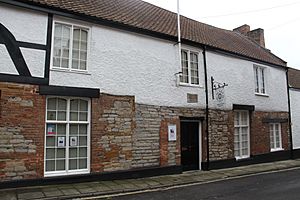Blake Museum facts for kids

The Blake Museum at
5 Blake Street, Bridgwater |
|
| Lua error in Module:Location_map at line 420: attempt to index field 'wikibase' (a nil value). | |
| Location | Bridgwater, Somerset |
|---|---|
The Blake Museum is located in Bridgwater, Somerset, England. It is believed to be the birthplace of Robert Blake, a famous historical figure known as a General at Sea. Since April 2009, the museum has been managed by Bridgwater Town Council. They get help from a group called the Friends of Blake Museum. It has been an officially recognized museum since 2006. The museum is right next to the Bridgwater Town Mill, and there are plans to make the mill an exciting new part of the museum.
Contents
The Museum Building's Story
This old building is special because many believe it's where Robert Blake was born. He was a very important leader in the navy, called a General at Sea. The house was built a long time ago, around the late 1400s or early 1500s.
It is recognized as a Grade II* listed building by English Heritage. This means it's a very important historical building that needs to be protected. The building has three floors and is made from limestone and hamstone. Some of its original ceilings are still there, showing how houses were built centuries ago.
What You Can See at the Blake Museum
The Blake Museum was started in 1926 by Bridgwater Borough Council. It collects items from a wide area around Bridgwater. In 1974, Sedgemoor District Council took over running the museum. Then, in 2009, the museum returned to the town council's care.
Robert Blake's Legacy
The museum has many items connected to Robert Blake's life. Even though people often call him "Admiral Blake," his real title was General at Sea. This role combined the jobs of an admiral and a navy commissioner. One of the most interesting items on display is Blake's own sea chest.
Bridgwater's Rich History
The museum also shows Bridgwater's past as a busy trading port. It highlights important local events, like the Battle of Sedgemoor. There's a special display about this battle, showing how it looked. The museum's "Battle gallery" also covers other conflicts. These include battles from the time of King Alfred and the English Civil War. It even includes events from the 20th century.
The museum has a complete collection of newspaper clippings from The Bridgwater Mercury. These cover every week of World War I, from 1914 to 1918.
Other Interesting Collections
You can also find old farm tools and dairy equipment at the museum. There's a collection of coins found in the bank of King's Sedgemoor Drain. In 2012, the museum restored and displayed the Spaxton Mosaic, a beautiful ancient artwork.
The museum also has 19th-century women's clothing and many old photographs. You can see items related to ships and transport. There are also brick, tile, and textile items. The museum keeps an archive about the Monmouth rebellion. It also holds the works of local artist John Chubb (1746–1818).
The Blake Museum has even worked with the TV show Time Team, which explores archaeological sites.
Learning About Local History Online
The Blake Museum works closely with the Bridgwater Heritage Group. This group was started in 2012 to share detailed stories about the town's lost buildings online. The group now also digitizes historical texts about Bridgwater.
These texts are available as PDF documents that people can download and print. They include original historical research. The goal is to create a valuable learning resource for everyone. This helps local historians, school pupils, and college students learn more about Bridgwater's past.
In 2016, the museum celebrated its 90th birthday with a special exhibition.
Visiting the Museum
The Blake Museum is open to the public. During the Coronavirus crisis, the museum launched a Facebook Group called Bridgwater History. This group helped people learn about local history while the museum was closed. It became very popular, growing to over 3,400 members. It is a private group focused only on Bridgwater's history.

